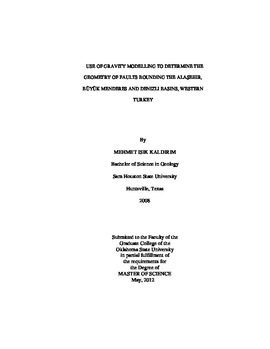| dc.contributor.advisor | Atekwana, Estella Akweseh | |
| dc.contributor.author | Kaldirim, Mehmet Isik | |
| dc.date.accessioned | 2014-03-14T21:51:59Z | |
| dc.date.available | 2014-03-14T21:51:59Z | |
| dc.date.issued | 2012-05-01 | |
| dc.identifier.uri | https://hdl.handle.net/11244/8031 | |
| dc.description.abstract | In this study, we use Bouguer gravity data and Digital Elevation Models (DEM) extracted from Shuttle Radar Topographic Mission (SRTM) data over Western Anatolia region to investigate the surface and subsurface structures of the Menderes Massif. The specific objectives were to: (1) investigate the geometry of the faults bounding the Alasehir, Buyuk Menderes and Denizli basins, (2) delineate the lateral extent of the Southwest Anatolia Shear Zone (SWASZ) within the study area and (3) investigate the relationship between the SWASZ and the faults associated with these basins. Our results suggest the following: (1) gravity anomaly values over the basins range between -30 to -60 mGals corresponding to a Quaternary sediment thickness of 3- 4 km with the thickest (~7-8 km) sediments modeled over the eastern part of the Denizli basin. The steep angle and deep nature of faults bounding this basin may provide conduits for bringing deep hydrothermal waters to the surface (2) the geometry of the basins is characterized by detachment faults that have a low angle due to flexural rotation and by the steeper angle antithetic faults bounding the opposite sides of the basins. (3) The SRTM-DEM density slicing suggests that the Denizli Basin might be a southeasterly extension of the Alasehir basin but segmented by cover volcaniclastic material. (4) The SWASZ is well defined on the filtered gravity maps and is characterized by right-stepping en echelon faults that extend as far as the north of the Denizli basin where it curves westward and continues along the edges of the north south trending faults forming the Gordes, Demirci and Usak-Gure Basins. (5) SWASZ controls the eastern margin of the Denizli Basin and may possibly explain the earthquake activity observed within the eastern part of the Denizli Basin. | |
| dc.format | application/pdf | |
| dc.language | en_US | |
| dc.publisher | Oklahoma State University | |
| dc.rights | Copyright is held by the author who has granted the Oklahoma State University Library the non-exclusive right to share this material in its institutional repository. Contact Digital Library Services at lib-dls@okstate.edu or 405-744-9161 for the permission policy on the use, reproduction or distribution of this material. | |
| dc.title | Use of Gravity Modelling to Determine the Geometry of Faults Bounding the Alasehir, Buyuk Menderes and Denizli Basins, Western Turkey | |
| dc.type | text | |
| dc.contributor.committeeMember | Cemen, Ibrahim | |
| dc.contributor.committeeMember | Boardman, Darwin | |
| dc.contributor.committeeMember | Puckette, James | |
| osu.filename | Kaldirim_okstate_0664M_11930.pdf | |
| osu.college | Arts and Sciences | |
| osu.accesstype | Open Access | |
| dc.description.department | Boone Pickens School of Geology | |
| dc.type.genre | Thesis | |
| dc.subject.keywords | gravity alasehir basin | |
| dc.subject.keywords | gravity buyuk menderes basin | |
| dc.subject.keywords | gravity denizli basin | |
| dc.subject.keywords | gravity menderes massif | |
| dc.subject.keywords | gravity soutwest anatolian shear zone | |
| dc.subject.keywords | menderes massif | |
